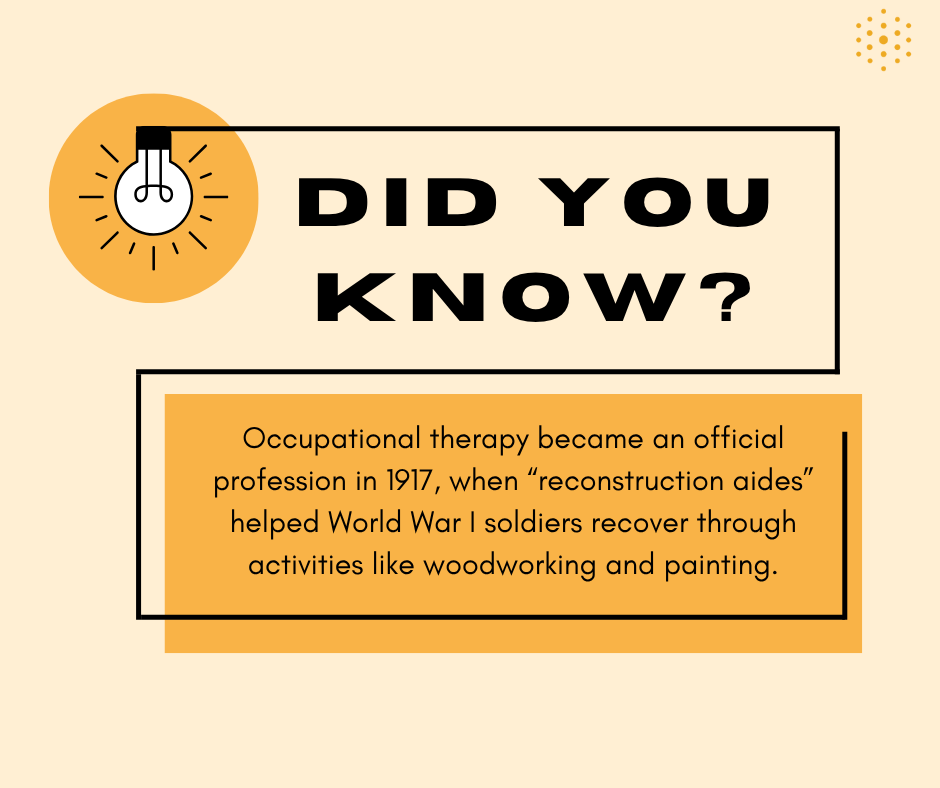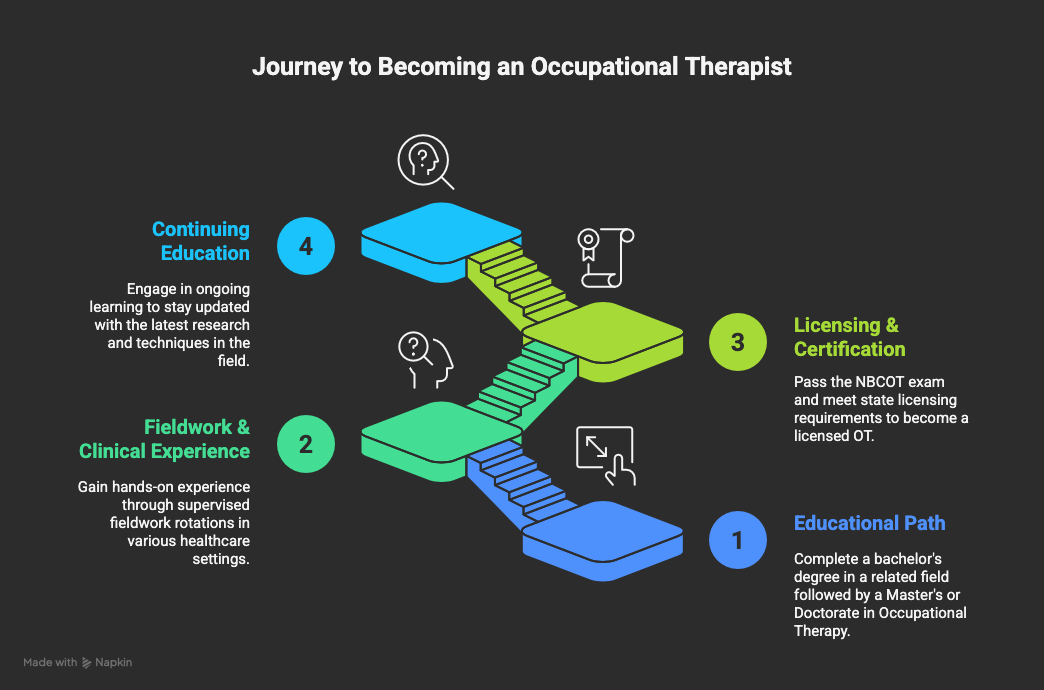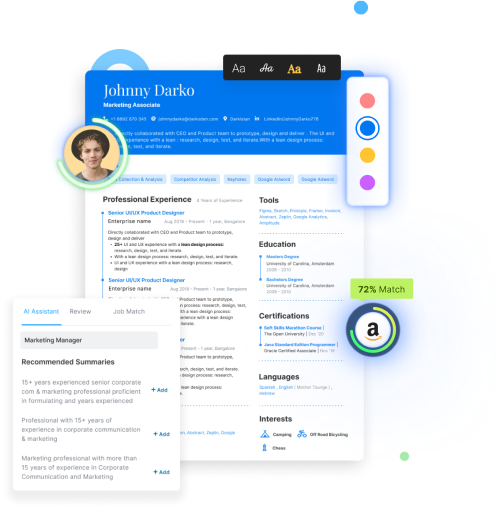What do occupational therapists really do — and why is their work so impactful?
Occupational therapists help people of all ages live more independent, fulfilling lives by enabling them to perform everyday activities despite physical, mental, or developmental challenges. Their work spans hospitals, schools, and community settings — blending medical science with empathy to support recovery, adaptation, and wellness. With demand projected to grow 14% by 2032, this career offers both stability and purpose for those passionate about human connection and meaningful change.
Did you know that employment for occupational therapists is projected to grow 14% from 2022 to 2032 - nearly three times faster than the average for all occupations, according to the U.S. Bureau of Labor Statistics.
That’s because occupational therapy is one of the most vital and versatile fields in modern healthcare.
Occupational therapy empowers people of all ages, from children to older adults, to live independently, recover from injury, and participate fully in everyday life.
If you’re considering a career that blends science, empathy, and impact, becoming an occupational therapist might be a perfect fit.
In this guide, we’ll explore what occupational therapists really do, the skills and qualifications required, and why this profession is in such high demand today.
What is the Real Goal of Occupational Therapy?
The main goal of occupational therapy is to help people of all ages do the things they want and need to do through the therapeutic use of daily activities, also known as "occupations."
Occupational therapists look at the whole person. They want to know what's important to you and what you want to be able to do.
“Occupations” are not just about your job. They include all the meaningful activities of daily life, from self-care (getting dressed, eating) to leisure (hobbies, sports) and social participation.
According to the College of Health Professions at the University of Tennessee Health Science Center, occupational therapists use these meaningful activities with specific goals to help people of all ages prevent, lessen, or adapt to disabilities.
This holistic approach makes occupational therapy a deeply personal and effective form of treatment.
Also Read: How much do occupational therapists earn?
How Do Occupational Therapists Support Mental Health?
Occupational therapists are key players in mental healthcare. They help people with mental health challenges by teaching coping strategies, creating meaningful routines, and helping them re-engage in their communities.
The need for mental health support is immense.
Recent data released by World Health Organization shows that more than 1 billion people people in the world were living with a mental disorder.
Occupational therapy for adults with mental health conditions can be a game-changer.
For someone with depression, an OT might help them structure their day to include activities that bring them a sense of accomplishment.
For a person with an anxiety disorder, an OT might teach them self-regulation strategies to use in stressful situations.
Research has shown that occupational therapy can improve education and work performance in adults living with a serious mental health condition, according to Alliant International University.
Also Read: What are some commonly asked interview questions for occupational therapists?

What is an Occupational Therapist's Role in Schools?
In schools, occupational therapists help children with and without disabilities to participate fully in school activities and improve their performance in areas like handwriting, attention, and social skills.
For example, an OT might work with a child on their fine motor skills to improve their handwriting or help a child with sensory processing issues to better focus in the classroom.
They often use a three-tiered model of support, providing universal support for all students, targeted interventions for at-risk students, and intensive, individualized therapy for students with the greatest needs.
What's the Difference Between Occupational Therapy and Physical Therapy?
While both are crucial for rehabilitation, occupational therapy focuses on improving a person's ability to perform daily activities, while physical therapy focuses on improving a person's physical function and movement.
It's a common point of confusion, but the two fields have distinct goals.
A physical therapist will work with a patient who has had a stroke to improve their strength and balance.
An occupational therapist will work with that same patient on how to safely get dressed, cook a meal, or get back to their hobbies.
| Category | Occupational Therapy (OT) | Physical Therapy (PT) |
|---|---|---|
| Primary Goal | Help people perform daily activities independently—self-care, school, work, and leisure. | Improve movement, strength, balance, and overall physical function. |
| Core Focus | Daily tasks, environment adaptation, and cognitive or sensory needs. | Muscles, joints, and mobility recovery after injury or illness. |
| Typical Activities | Dressing, cooking, handwriting, and re-learning everyday routines. | Stretching, strength training, balance exercises, and gait practice. |
| After a Stroke (Example) | Teach safe dressing, meal prep, and re-engaging in hobbies. | Rebuild strength, balance, and walking ability. |
| Environment | Homes, schools, community centers, or workplaces. | Hospitals, rehab clinics, or outpatient centers. |
| Outcome | Greater independence and participation in meaningful activities. | Improved physical strength, flexibility, and movement. |
Quick take: Physical therapy restores movement; occupational therapy helps people apply that movement in daily life.
What Skills Define a Great Occupational Therapist?
A great occupational therapist has a unique blend of strong interpersonal skills, like empathy and communication, and sharp technical skills, including problem-solving, critical thinking, and a deep understanding of anatomy and physiology.
Being an effective occupational therapist is about more than just knowing the right exercises.
You need to be able to connect with people on a human level, understand their struggles, and motivate them to reach their goals.
According to Husson University, skills like active listening, empathy, and adaptability are crucial for building trust and providing compassionate care.
At the same time, OTs need to be excellent problem-solvers, able to assess a person's needs and create a tailored treatment plan.
How to Become an Occupational Therapist?
To become a licensed occupational therapist, you need a blend of formal education, clinical training, and certification. The journey combines rigorous academic preparation with real-world experience.
- Educational Path: Most occupational therapists start with a bachelor’s degree in a related field such as biology, psychology, or health sciences. After that, they must complete a Master’s in Occupational Therapy (MOT) or a Doctorate in Occupational Therapy (OTD) from an accredited program. These programs typically include coursework in anatomy, neuroscience, mental health, and rehabilitation sciences.
- Fieldwork & Clinical Experience: Hands-on experience is a cornerstone of training. Students complete supervised fieldwork rotations, where they work directly with patients in hospitals, schools, or community clinics to apply their classroom learning in real settings.
- Licensing & Certification: In the U.S., all practicing OTs must pass the National Board for Certification in Occupational Therapy (NBCOT) exam to earn their license. Each state may also have additional licensing requirements.
- Continuing Education: The field evolves constantly with new research and therapeutic techniques, so OTs are expected to complete continuing education courses throughout their careers to maintain licensure and stay current.
Also Read: What are some essential skills you need to advance your career?

Conclusion
Occupational therapy is more than a career, it’s a calling that combines compassion with science to help people lead fuller, more independent lives.
Whether you’re guiding a child toward better focus in school, supporting an adult’s return to work after an injury, or helping someone regain confidence in everyday tasks, the impact of this profession is profound.
If you’re preparing to step into this rewarding field, showcasing your qualifications and passion clearly can make all the difference.
Hiration can help you craft a compelling resume, refine your interview approach, and present your best self on LinkedIn, as you pursue your career in occupational therapy.
Here’s to building a career that truly changes lives, starting with yours.
Occupational Therapy — FAQ
What is the main goal of occupational therapy?
The goal is to help people participate fully in daily activities (“occupations”) that are meaningful to them — from self-care and work to leisure and social participation. Therapists focus on improving independence, function, and quality of life.
How does occupational therapy differ from physical therapy?
Physical therapy focuses on restoring movement and strength, while occupational therapy helps patients apply those abilities to everyday tasks — like cooking, dressing, or returning to work — for greater independence.
How do occupational therapists support mental health?
They help clients develop coping mechanisms, create healthy routines, and engage in meaningful activities. This support can improve confidence, structure, and community participation for individuals with mental health challenges.
What role do occupational therapists play in schools?
OTs work with students to enhance handwriting, attention, sensory processing, and social skills. They use a three-tiered approach — universal, targeted, and individualized — to support learning and participation for all students.
What skills make a great occupational therapist?
Empathy, active listening, adaptability, and strong problem-solving are essential. OTs also need technical expertise in anatomy, mental health, and rehabilitation to design effective, personalized treatment plans.
What qualifications are needed to become an occupational therapist?
Prospective OTs typically complete a bachelor’s degree in a related field, followed by a Master’s or Doctorate in Occupational Therapy (MOT or OTD). They must also pass the NBCOT exam and meet state licensure requirements.
Do occupational therapists need ongoing education?
Yes. OTs must complete continuing education to maintain licensure and stay current with research, new technologies, and evolving therapeutic approaches in healthcare and rehabilitation.
What makes occupational therapy a rewarding career?
OTs directly improve lives — helping children thrive in school, adults recover after injury, and older adults maintain independence. The field offers both emotional fulfillment and strong job growth prospects.



